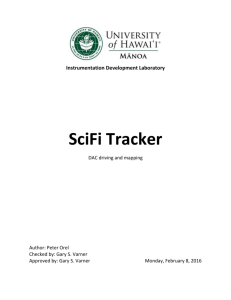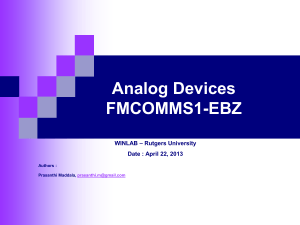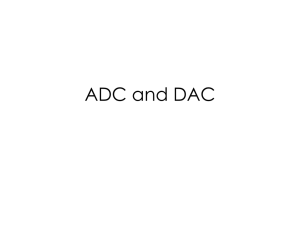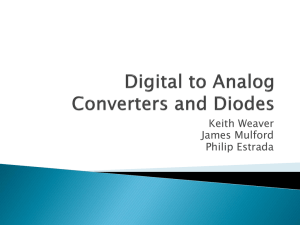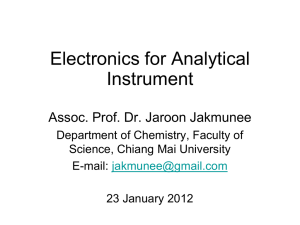DAC
advertisement
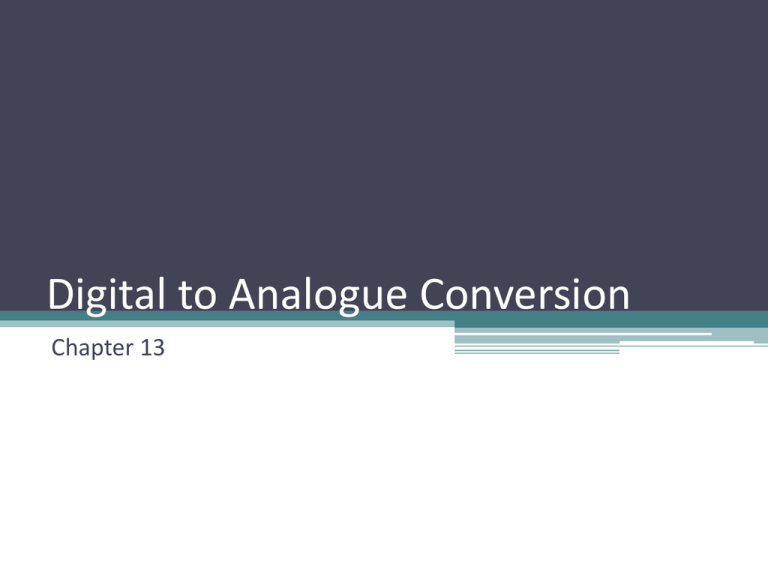
Digital to Analogue Conversion
Chapter 13
Why is conversion needed?
• Most signals in the world are analogue.
• Microprocessors and most computers computers use
digital signals.
▫ Analogue to Digital Converters (ADCs) change
analogue signals to digital signals that are then used
by the microprocessor.
▫ Digital to Analogue Converters (DACs) may be used to
change digital signals to analogue signals that are
then used by the peripherals attached to the
microprocessor.
ADCs and DACs
• ADCs tend to be more common on a microprocessor.
▫ The number of peripherals that have ADCs and DACs
integrated inside is increasing so the microprocessor
may not need this capability in the future.
Why? Because more peripherals are manufactured with
integrated ADCs. However, you then need to decide
type of format that the digitized data will be transferred
to your microprocessor
Examples: I2C, CAN, SPI, ethernet, USB
mbed
Note: Analogue (UK) and Analog (US) are two different spellings for the same word.
Digital to Analogue Conversion (DAC)
Block Diagram
• D is the digital input.
• Vo is the Analog
output.
• Vr is a precise, stable, known
voltage reference,
• There are some control lines
that are used to determine how
often the DAC should convert
the input signal, for example.
A relatively straightforward DAC can be realised using a resistor
network, a common type is the R-2R ladder
Digital In
Dn-1
MSB
Dn-2
D2
D1
Do
LSB
Vout – Analog Out
2R
R
2R
.
.
2R
2R
2R
R
R
2R
Good test of your knowledge
of Thévenin’s theorem, can
you show that:
V
Vout nr (Dn1 2n1 Dn2 2n2 ... Do 20 )
2
A simple relationship usually relates the digital input to the
analog output, such as Vo is the analog output voltage
D is the value of the binary input word
D
Vo n Vr
n is the number of bits in the input word
2
Vr is the value of the voltage reference
Output Voltage (Vo)
Vr
(2n-1)Vr/2n
(2n-2)Vr/2n
2Vr/2n
Vr/2n
000 001
010
2
-2 2binary
-1 number)
D2(input
n
n
n
Analog Output
• There are a finite set of voltages that are generated by
the DAC.
▫ For each digital input value, there is a corresponding
analogue output voltage.
▫ Number of possible output voltages is 2n (number of bits
in the word)
• The range of the DAC is the difference between the
maximum and minimum output values.
• The resolution of the DAC is the step size between each
Vr
analog value.
2n
• Conversion speed is the inverse of the time that it takes
the DAC to act on changes to the input.
Maximum possible output value occurs when D = (2n-1).
The value of Vr as an output is never reached. (Review the R-2R
figure to determine why.)
3 bit DAC where Vr = 3V
D
000
001
010
011
100
101
110
111
Vo
0V
3/8 V
6/8 V
9/8 V
12/8 V
15/8 V
18/8 V
21/8 V
(0 V)
(0.375 V)
(0.75 V)
(1.125 V)
(1.5 V)
(1.875 V)
(2.25 V)
(2.625 V)
3 bit DAC in previous example
• Maximum number of analog output voltages?
• Range of the DAC?
• Resolution of DAC?
Key Features of the NXP LPC 1768
mbed
• The LPC1768 has a 10 bit DAC, and uses its
regulated 3.3 V power supply as the voltage
reference.
▫ What are the number of steps, range, the
resolution, the range, and the conversion speed of
the LPC1768 DAC?
It takes 5 ms per conversion.
How many clock cycles does this conversion take?
mbed
• The mbed’s LPC1768 chip has a 10-bit DAC (i.e. n=10).
• The mbed uses its own 3.3 V power supply as voltage
reference.
• There will therefore be 2n steps in the mbed DAC output
characteristic, i.e. 1024.
• The step size, or resolution, is therefore be 3.3/1024, i.e. 3.2mV
per bit.
• The conversion speed is 200,000/s. The clock speed is 100 MHz
so the conversion time is equivalent to 500 clock cycles.
• There is another specification called the sampling frequency.
The maximum sampling frequency provides a limit to the speed
at which the digital signal can be sent to the DAC
It is relatively easily check the resolution of the DAC.
For example, create an extremely slow sawtooth. In this case, it
takes 10,000 steps to reach the max value with a 1 second interval
between each step. The period of the waveform is about 2
hours 45 minutes, but this is not the point.
/* Program to check DAC resolution of mbed*/
#include “mbed.h”
AnalogOut Aout(p18);
DigitalOut led1(LED1);
float i;
int main(){
while (1){
for (i=0;i<1;i=i+0.0001){
Aout=i;
Note: By the end of this course, you
wait(1);
should be able to go through a simple
led1=!led1;
program and describe what each line of
}
code means and what the mbed will do
}
as a result. You should also be able to
write a simple program for the mbed .
Measurement
• Connect the AnalogOut pin to a voltmeter or an
oscilloscope.
• LED flashes each time that a new analog value is
outputted by the DAC.
• However, 10,000 is larger than the maximum
number of steps for the mbed DAC.
• So, the DAC output voltage only changes on
approximately every 5th step and when it does,
the output voltage changes by about 3 mV.
• The float value is rounded to the nearest digital input to
the DAC.
Ideal DAC
From Understanding Data Converters, Texas Instruments Application Note
Offset Error
From Understanding Data Converters, Texas Instruments Application Note
Gain Error
From Understanding Data Converters, Texas Instruments Application Note
Gain Error
Total Error
Offset Error
Nonlinearity Error
From Understanding Data Converters, Texas Instruments Application Note



